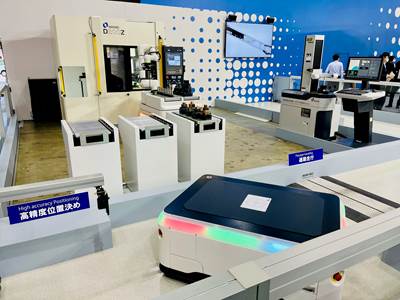Share





What do aerospace, wind energy and automotive parts all have in common? A strong, information-based production plan; rigid, high-precision machining; and preferably some form of automation to make up for labor shortages. This is true across both Europe and North America and plays into an idea that I found again and again at BIEMH 2024: Most challenges facing European manufacturers echo those facing their American counterparts. Their solutions do the same, with digitalization, automation and multitasking machines just as important on the European side of the Atlantic as the North American.

BIEMH 2024, which took place in the Bilbao Exhibition Center in Bilbao, Spain, played host to just over 1600 exhibitors across 6 halls, with almost 38,000 attendees.
Digital Deduction
Carlos Teixeira, CEO of CHETO Corporation, says that while adoption of computers onto the manufacturing floor may have had a slow start in parts of Europe, digitalization is a major concern for shops across the continent today. Julian Bardullas, area sales manager at Willemin-Macodel, agreed, noting that he has seen machine monitoring and other software that pulls data from machines become a major factor in European machining.
Several manufacturers at the show demonstrated their own contributions to the software market, including CHETO, which debuted its Smart Hole Inspection machine and software for European moldmakers after a U.S. launch earlier this year at NPE. Smart Hole Inspection checks the flow rate of circuits and cleans molds’ cooling lines while also generating conformity reports — Teixeira says these functions meet a formerly unfulfilled need in the market. Fagor Automation also launched a digital suite to monitor efficiency on everything from drives to PLCs to CNCs, calling on several of its customers in nearby booths to provide testimonials. This included TDG Clamping Solutions, a workholding company also making moves into the smart technology space. Its recent “Smart Chucks” use force sensors to warn users when their cutting forces are growing too strong for the part being machined. Company representatives say that this move supports automation, which he sees as increasingly vital to manufacturing.
The Automation Equation
In addition to some eye-catching displays of robot arms programmed for novelty purposes (including one with a vision system that held its own in foosball), autonomous mobile robots (AMRs) showed up in several halls at BIEMH. A representative of Kuka Robotics says that AMRs are relatively new in the market, hence the focus on them, with another major focus across robotics brands at the show being the connections between robotics and digital tools.

Robots were a common sight on the show floor — both in conjunction with machine tools and as part of standalone displays. This foosball-playing robot from FANUC drew consistent crowds of challengers who (mostly) lost to the robot.
The show also played host to a few demonstrations of robots for additive purposes. This includes additive company Meltio, which saw a steady stream of visitors to its machine, which uses a six-axis robot and a two-axis rotary table to position the printing head to increase flexibility in material deposition.
Though the Titan additive machine brought by innovation group Techniker did not use a robot, Technology Transfer Director José Miguel Landeta noted that they have several additive machine combining these technologies in their own facility. These machines use robotic arms as travels and are thereby able to create larger parts than even the Titan’s large travels permit (for context, the Titan’s X-axis travels measure about 1.9 m). Besides the Titan, Techniker demonstrated 3D vision for bin picking at the booth, with Landeta mentioning that traditional robotics are still rapidly growing in prominence and importance within the European manufacturing marketplace.
Multipurpose Multitasking Machines
Beyond automation, many machine tool manufacturers at BIEMH put forward their multi-tasking machines as methods of attaining greater productivity. Willemin-Macodel demonstrated a custom multi-tasking machine at its booth, with Bardullas saying that 80% of the machining on the machine gets completed in the initial chucking, with the rest on a subspindle. The compact machine takes up much less space on a shop floor than dedicated machines for each manufacturing process — enabling users to fit more machines into their buildings — and reduces inaccuracies stemming from rechucking between machines.
Similarly, Ignacio Mera, area manager at Ibarmia, discussed the importance of integrating multiple processes to complete parts on a single machine (and preferably in a single chucking), pointing to the user-customized multitasking machines on display at the company’s booth. Though Mera admitted that the wide variety of features on their Z-series of multi-process machines makes them unsuitable for machining greenhorns, he said that same versatility makes them valuable for many different applications.
Gurutzpe has also seen the growing importance of multitasking machines combining multiple manufacturing processes. Like several other people I spoke with across the show floor, Luken Belaustegi, sales manager at Gurutzpe, mentioned that today’s standout machines are less about inventing a new manufacturing paradigm (like the advent of numerical control or additive manufacturing) than refining and combining current processes into a single machining platform to get as close to done-in-one machining as possible.

Companies across every hall of the show introduced digital solutions alongside their machines to bring data to users’ fingertips. While AI itself did not have a large presence at the show, multiple company representatives believe this digitalization push is a prelude to the growth of AI in manufacturing.
Appealing to Buyer and User
Representatives from several companies also spoke of the importance of appealing to customer and end-user needs. While the machine customization mentioned above is a key part of this appeal, two other themes and observations stood out.
First, many companies see AI as a potential tool for the future — but not the present. Kuka and Lagun representatives both noticed the rising importance of AI at the show, though Aitor Agirre, Lagun’s general manager, notes that these are still early prototypes and the technology has yet to mature. TDG Clamping Solutions’ representative, meanwhile, was clear that its digitalization strategy is meant to benefit both shops automating now and any leveraging AI in the future. That is, by gathering data now, the company is facilitating the creation of data for training AI.
Secondly, machine design itself is a tool for appealing to new generations of manufacturing talent. For example, Agirre says that he has noticed that younger generations are less interested in manual machines, with computerization a key factor in appealing to younger potential talent. From a different angle, Bardullas drew attention to the aesthetic design of Willemin-Macodel’s custom machine. He says that after redesigning external casing of the machine for visual appeal, Willemin-Macodel has had better luck catching the interest of people unfamiliar with the industry. While computerization and aesthetic design are vastly different areas of design, both serve a similar purpose for newcomers: they promise a modern work environment, one that looks forward to the future rather than halting in the past. Judging from the crowds of show attendees young and old near the visually impressive robotics demonstrations, this may prove a winning strategy.
Related Content
How to Mitigate Chatter to Boost Machining Rates
There are usually better solutions to chatter than just reducing the feed rate. Through vibration analysis, the chatter problem can be solved, enabling much higher metal removal rates, better quality and longer tool life.
Read MoreInside the Premium Machine Shop Making Fasteners
AMPG can’t help but take risks — its management doesn’t know how to run machines. But these risks have enabled it to become a runaway success in its market.
Read MoreThe Future of High Feed Milling in Modern Manufacturing
Achieve higher metal removal rates and enhanced predictability with ISCAR’s advanced high-feed milling tools — optimized for today’s competitive global market.
Read MoreCNC Machine Shop Honored for Automation, Machine Monitoring
From cobots to machine monitoring, this Top Shop honoree shows that machining technology is about more than the machine tool.
Read MoreRead Next
Automation and Flexibility Counter Inflation at BI-MU 2022
Automation headlined BI-MU 2022, while flexibility underscored exhibitors’ products. These twin benefits may be shops’ greatest assets against inflation.
Read MoreDigital Solutions Dominate TIMTOS
At TIMTOS, many OEMs highlighted solutions designed to overcome challenges that may sound familiar to U.S. manufacturers.
Read MoreIntegration, Automation and Green Tech Highlight JIMTOF 2022
Known as one of the largest machine tool trade shows in the world, the Japan International Machine Tool Fair (JIMTOF) has a reputation for being a machining technology show more than a machine tool sales event. And this year’s show in Tokyo — the first in-person Japanese machine tool trade show in four years — did not disappoint.
Read More































